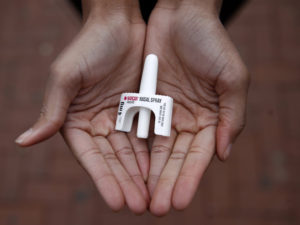Earlier this year, the Centers for Disease Control and Prevention released a stunning statistic. Seventy-two thousand people, it estimates, died of drug overdoses in 2017. The huge increase in deaths is largely due to heroin and powerful synthetic opioids like fentanyl.
One of the tools being used to fight that wave of deaths is the drug naloxone. It’s been called the Lazarus drug for its ability to revive people dying from overdoses. It can be injected or simply administered through a nasal spray. (The spray form of the drug is known by the brand name Narcan.)
Twenty-four-year-old Tiffany — whose last name is being withheld to protect her privacy — owes her life to naloxone.
“I’ve overdosed nine times,” she says.
Each time she overdosed, Tiffany was revived with naloxone.
Another heroin user, James, says he has also been brought back with naloxone, and that he’s used the drug on friends who “fall out,” or lose consciousness.
“I’ve got five or six nasal spray Narcans up in my room, so if someone else falls out around me, when you shoot it up their nose, not even ten, fifteen seconds later, they are back,” he says.
Tiffany and James say naloxone has not changed the way they think about heroin, but both have friends who treat naloxone like a safety net. Tiffany says she has one friend who assumes that “if he overdoses, someone will come give him Narcan and bring him back.”
But would her friend stop using heroin if he didn’t have Narcan?
“No,” she says. “There ain’t no way.”
The possibility that naloxone might lead to greater risk taking among drug users prompted two economists to study the issue. Their controversial and hotly-debated findings suggest naloxone not only increases risky drug use but may actually cause more deaths than it saves. Public health researchers say these findings are based on flawed data and analyses.
This week on Hidden Brain, we talk with users, families, and researchers about risky drug use. We’ll try to understand the complex risk/benefit calculations involved in opioid use, and why there’s still so much we’re struggling to understand about addiction.
Additional Reading:
The Moral Hazard of Lifesaving Innovations: Naloxone, Access, Opioid Abuse, and Crime, by Jennifer L. Doleac and Anita Mukherjee
Does Naloxone Availability Increase Opioid Abuse? The Case for Skepticism, by Richard G. Frank, Keith Humphreys, Harold A. Pollack
With a Little Help from My Friends: The Effects of Naloxone Access and Good Samaritan laws on Opioid Related Deaths, by Daniel I. Rees, Joseph J. Sabia, Laura Argys, Joshua Latshaw, & Dhaval Dave
Opioid-overdose laws association with opioid use and overdose mortality, by McClellan C, Lambdin BH, Ali MM, Mutter R, Davis CS, Wheeler E, Pemberton M, Kral AH.

